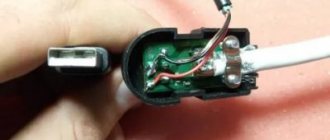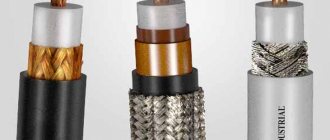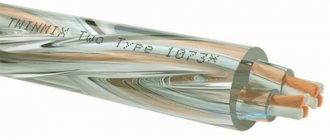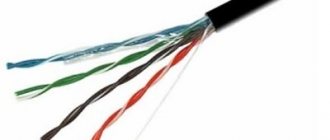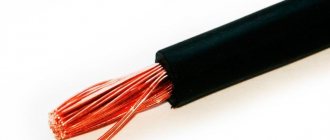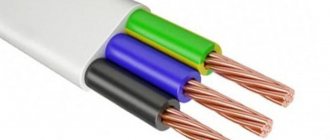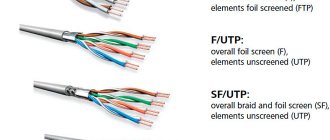Connecting television equipment is a simple matter. But this is at first glance. In fact, even experienced technicians sometimes get confused when it comes to choosing an antenna cable for a TV. Marking, thickness, technical characteristics - all this must be taken into account to make the right choice. We suggest studying all the nuances of this issue.
- Coaxial cable for TV - brands and characteristics
RG-6
- RK 75
- RG 59
- SAT 50
- SAT 703
- DG 113
- Installation and operation
Cable bending problems
- Which cable is better to choose?
- In conclusion
The structure of a television cable
Absolutely all models of such products have similar content. The components are:
- Inner conductor. It can be made in the form of a single or multi-core wire, as well as a copper tube. Multi-core products are characterized by a greater degree of elasticity and endurance. It can be all copper or copper coated steel.
- Dielectric layer. Provides static position of conductors. The material used for its manufacture is usually polyethylene, fluoroplastic or foamed polyvinyl chloride. Foamed dielectric provides greater flexibility. The only negative is the absorption of moisture, which significantly impairs the functional characteristics.
- Outer conductor, or braid. Has an insulating function. Can be made of foil, corrugated tube, aluminum film, metal wire. Protects the conductor from third-party negative radiation, or electromagnetic interference (EMI).
- Shell. Protecting the internal structure of the wire from the negative influences of climatic and chemical nature.
Coaxial cable for TV
A cable of this structure is also called coaxial . Therefore, everything that is written in this article will help you understand which is the best coaxial cable to buy for your TV.
TV cable design
Coaxial cable device
The design of most cable television products is almost the same, since they include the following similar parts:
- The central core is in the form of a thin copper conductor;
- The dielectric sheath insulating this core is made of polyurethane;
- A layer of shielding foil;
- Additional screen based on steel (copper-plated) wire;
- PVC protective sheath.
Coaxial cable device
Note! Because of this design of television cable, it is sometimes called coaxial.
The central copper conductor is the main material medium that ensures the propagation of the television signal within the coaxial channel formed by the wires together with the shielding braid. Screen steel braiding is an excellent protection of the coaxial channel from electromagnetic interference and other parasitic interference.
The internal insulating sheath performs its assigned function, and the outer PVC coating protects the entire cable from mechanical deformation and damage.
Purpose and parameters of the main components
The central core of a cable product can have two designs, in one of which it is made of copper-plated steel wire, and in the second of pure copper. Copper conductor is used to transmit all types of television signals, as well as to power satellite TV converters via coax.
Additional Information. The cable for satellite television must also have only a copper central core (diameter is about one millimeter). In all other cases, copper-plated wire will do just fine.
At the same time, it is possible to save on material costs with a relatively high quality of signal transmission.
The reliability of the existing screen braid determines how efficiently a TV signal is transmitted via a coaxial line, as well as protection from interference from extraneous sources. Therefore, this part of the cable during its installation requires a special approach (in terms of cutting the braid and its reliable fixation).
Aluminum foil (lavsan) is used to make screen film, and the braid itself can be made on the basis of copper or tinned wire (sometimes the same aluminum is used for its manufacture). Choosing the right television cable with this design means ensuring a high shielding coefficient (about 60-80 dB, and in some cases up to 90 dB).
The polyethylene (PE) dielectric present in the internal part reliably protects the central core and at the same time insulates it from unwanted contact with the screen and outer braid. The outer PVC sheath, in addition to reliable protection against deformation, protects the cord from moisture, dust and strong temperature changes (when laid outside buildings and on strings).
Which cable to choose for satellite, digital, cable TV
Direct connection to television equipment does not cause problems or difficulties in selecting the desired type of product. However, a number of older models are not equipped with decoders. For this reason, to watch digital television, you will need to connect a digital receiver. In addition, you need to find a cable to connect the set-top box directly to the TV.
Modern receivers have connectors of various formats, which means a wide selection of cables. They share one important characteristic. We are talking about throughput - it is what is responsible for the maximum image clarity that the wire from the receiver can provide after decoding the digital signal. In other parameters the products are different.
Experts say that purchasing a cord for each type of television is unprofitable. This is due to the fact that the frequencies of such channels do not differ much from each other and fit within the range of 49-800 MHz. Such a gap is qualitatively “covered” by absolutely all types of brands SAT 50, RG 6, SAT 703, DG 113 and RK 75 . If the total wiring length ranges from 20 to 30 meters, feel free to buy one type of product.
Coaxial Cable Specifications
Antenna wire for satellite television
The broadcast frequency of satellite channels ranges from 1-3 GHz, which is extremely different from analog television. They are more susceptible to interference and require effective shielding. In addition, the frequency of data receipt is higher. Focus on the task that the cable must perform - transmit a signal without significant losses. To do this, it must be wider and equipped with an outer shell that is resistant to various weather conditions.
For satellite television, it is recommended to consider values exceeding the optimal characteristics, for example, SAT 50, SAT 703, DG 113.
Analog cables
Of course, we twisted our hearts a little when we said that for a good image it is enough to choose the right cable. In fact, the quality of the received image—its resolution—plays a more important role.
But, nevertheless, this does not detract from the merits of the wires, since if you install a cable that does not correspond to it on a high-quality signal, all you will see is the maximum throughput of the selected option, that is, the image will become worse. We will reveal this dependence in more detail throughout the article.
Which TV cable is better: the difference in quality between analog and digital signals
Today there are two types of broadcast signals: analog and digital. We won’t go into physics and just outline the main difference.
Their transmission principle is similar, and some cables are capable of transmitting both signals. The main difference is that a digital signal is a square wave and carries only two possible values: one is a zero and the other is a one.
Schematic representation of the analogue and figures
That is, all information is transmitted in the form of binary code, like in a computer. Thanks to this, it is possible to cut off all the interference that abounds in the analog signal, and transmit the picture with sound in its original quality. In addition, the analog signal transmits a lot of unnecessary information, which reduces the throughput of these cables.
All this does not mean that an analog connection cannot transmit a high-quality signal. In some situations, the use of such wires is preferable to their modern competitor. Let's list all the analog cables used so far and figure out how to connect them
Coaxial cable
An analog antenna and a satellite dish are connected with a coaxial cable
Here is a standard television cable, which everyone, without exception, is probably familiar with.
It is made in the form of a round elastic wire, which consists of:
- Central vein;
- A dielectric, which acts as an internal insulator and envelops the central core along its entire length;
- Shielded interlayer - not all cables have it, as this increases the price per linear meter of the product.
- External conductor;
- An insulating sheath that protects the cable from damage.
This cable is used not only in television equipment, but also in communications, and even for military equipment. It can transmit both types of signals and has not lost its relevance for many years in a row.
In modern television systems, in addition to connecting external antennas, it is used: when connecting a satellite dish to the receiver; when connecting several receivers in series; on cable television. Consequently, the picture quality in all these cases will depend entirely on the coaxial cable.
Which coaxial cable is worthy of the end consumer's attention? To answer this question, you need to find out all the main technical characteristics of this product, and what external factors should be taken into account when choosing.
From this video you will learn how to choose the right TV cable.
Let's outline the main points:
- Cable resistance - as we remember from school physics course, resistance is measured in Ohms. For a good home cable, this parameter should be at least 75 Ohms. This value is stamped on the cable itself, and can simply indicate a specific number, or be encrypted, for example, RK - 75.75.
Resistance designation on the cable body
Advice! If you see a cable with one of the following markings - RG -6, RG -59, RG -11 - then you can safely purchase them, as they meet all the requirements for home television systems.
- Signal attenuation indicator - any television channel broadcasts on its own non-repeating frequency. Accordingly, each of them has its own level of signal attenuation - for some it is higher, for others it is the opposite. Therefore, you should purchase a cable with the lowest loss level, which is measured in dB/100m.
- Next, you should think about where the TV will be located and what route you are going to take to connect the wires to it. If a significant part of the cable (outside the window does not count) runs along the street, then it is worth choosing an option that is resistant to changes in temperature and humidity. To avoid mistakes, choose thicker wires with dense braiding, a powerful core, layers of carbon and various impregnations.
- Not every coaxial cable is suitable for transmitting a satellite signal. If your version has a central core less than 1 mm in diameter, then interference is inevitable. And all due to the fact that in addition to the signal, power for the convectors passes through it.
- It is better if the cable cores are made of copper.
- Choose options with a durable shell. Color doesn't matter.
- A layer of foil and dense braiding is required.
Now, regarding cable routing:
- It is possible to lay a coaxial cable next to power lines only if its thickness is at least 6 mm;
- The cable must not be bent more than 90 degrees, otherwise the dielectric shells may be damaged;
- The length is selected individually, depending on current needs;
- Use connectors and splitters to route the cable. Don't make homemade connections.
These tips will be useful to you to answer the question of how to improve your cable television signal. Now let's figure out how to mount a connector on a cable with your own hands. Here are instructions and photos on the topic.
- To begin, remove about two centimeters of the outer insulator;
- Then cut off the braid and internal dielectric, leaving about 5 mm at the base;
- Take a connector - in our case, this is an option designed for a satellite receiver, which has a screw thread for connection.
Connector for satellite receiver
- Place the connector on the end of the cable;
Connector installation
- The connector will be tight, so use some force to get it snug;
Connection ready
Well, to make the connection stronger and not fall apart during operation (the receiver can be moved to another place), reinforce it with regular electrical tape.
The insulating tape will prevent the connector from being disconnected from the conductive cores of the cable
We may have devoted too much space to this cable, but it is still the most versatile of all solutions.
Tulips are not only flowers
What is the best television cable: RCA cable, commonly known as “tulip”
All the cables that we will consider below are used to connect equipment indoors. It is impossible to purchase them as moldings and mount the connector yourself. And the first on our list will be, perhaps, the most popular option - a composite RCA jack cable. In Russia it is better known as “tulip” or “bell”.
The cable has three cores, each containing at the end a standard RCA (male) plug, which looks like a contact pin protruding forward, surrounded by a round rim of metal. The mating connector (“female”) is located on the contact panel of the connected equipment and has a diameter of 8 mm.
One core is intended for transmitting a video signal, and the remaining two are for stereophonic.
The image quality that this connector is capable of transmitting is quite good - it is quite capable of handling a 480p signal with minor losses in quality. The disadvantage is that the composite mixes signals together thanks to multiplexing technology, which is why the quality of the restored image deteriorates compared to the original. Such signals, when mixed, create the effect of blurring shades and primary colors along the boundaries of objects - the picture turns out to be slightly blurry.
Advice! High-quality, expensive models are equipped with a refractory core made of Teflon or ceramic, in contrast to more affordable ones, which use pressed fiberglass (this is the middle price segment), plastic and polyethylene (the cheapest options). The latter are generally afraid of overheating, so be careful when soldering.
In order for a receiver or DVD player connected in this way to start broadcasting the image, you need to select the connector on the TV from which it should read the signal.
Input button on the TV remote control
Circled in the photo above is a button on the remote that gives access to the TV's input jacks. By clicking it, you will see a drop-down menu with available or active inputs (depending on the manufacturer and the current firmware). The required inputs may be designated: AV; video or indicated by an icon like the next photo.
AV input in TV menu
The associated digit indicates the input number. Typically this value is duplicated on the panel containing the inputs.
S-Video cable
How do you know which TV cable is best to choose? To do this, familiarize yourself with all the inputs that your TV supports. Among them may be...
S-Video cable
S-Video is an analog component interface for transmitting video signals. It provides for separate transmission of brightness (Y) together with the synchronizer, and colors, which also have a color synchronizer. These parameters are transmitted separately from each other via communication lines with a resistance of 75 Ohms.
This method of data transmission provides better image quality compared to the previous option, although multiplexing technology is also used for this.
The best quality is achieved due to the fact that the cable design eliminates crosstalk. This standard was developed for broadcasting and is not suitable for HD quality images.
S-Video connector on the TV body
The cable cannot transmit sound, so it is separately equipped with two RCA wires for these purposes. In the photo shown, both S-Video and RCA are designated as AV in 3, and have common audio inputs.
The connectors come in 4- and 7-pin types and are equipped with appropriate cables. Today, this format is living out its days, and new equipment is not equipped with it, but you can improve the picture if you have such sockets on your paired devices.
SCART connection
SCART cable
This standard is a pan-European standard for televisions, DVD players and VCRs. The cable has a universal plug that combines all the signals that make up the format.
Through SCART, it is possible to transmit both analog and digital signals (the latter is supplied in the form of commands, for example, when you turn on the player, the signal is transmitted to the TV, and it also turns on). This function is a CEC protocol, thanks to which setting up the equipment is greatly simplified.
The shape of the connector will not allow it to be installed incorrectly. Like “tulip”, it is designated AV in the TV menu.
In terms of picture quality, it differs little from RCA, so what to choose depends on the availability of one or another connector on the TV.
Component connection
Component cable 3 RCA
YPbPr is actually a three-dimensional color space that is used in component analog video to separate the chrominance and luminance of a signal. In slang, this type of connection is called yipper. This signal is transmitted via three coaxial cables, which are equipped with RCA or BNC connectors. The connector type is selected based on the one installed on the equipment. If necessary, adapters can be purchased.
This type of connection is called component, although this is not entirely correct, since there are other types of component signals, such as RGB.
This abbreviation stands for as follows:
- Y (luma) is a cable that transmits sync pulses and brightness level;
- Pb – determines the difference between luma and blue level;
- Pr – similar to the previous one, but with a red color level.
On a note! The green color level is not transmitted, since this value can be calculated based on the specified three parameters using the formula: Green = 1.704 × luma - 0.509 × R ed - 0.194 × B lue.
Component input on the TV panel
It would seem that this standard is no different from RGB, since both three signals are transmitted. But do not forget that the Yipper was created thanks to the advent of color television, which was supposed to be compatible with black and white televisions. For this purpose, a brightness parameter was introduced, transmitting the picture in black and white format, so that old TVs could understand color, but without reproducing it (naturally), and vice versa - color TVs would perceive a black and white signal.
The color of SECAM, NTSC and PAL formats was transmitted at separate subfrequencies, and due to the fact that the color resolution of the human eye is less than brightness, color clarity was reduced by half compared to brightness. Cables for YPbPr are no different from conventional composite “tulips”, and can be interchangeable with them.
But this compound has undeniable advantages compared to those discussed earlier. Its bandwidth is much higher and allows you to transmit images up to 1080i. YPbPr divides signals without using multiplexing, so the output signal is exactly the same as the input signal, which makes this standard the best among analogue ones.
Coaxial cable for TV - brands and characteristics
Similar products are produced under various manufacturer brands. However, absolutely all of them have a characteristic impedance of 75 Ohms and are suitable for connecting one or more devices. Read more about the most famous and in demand cables.
RG-6
Produced in Russia. Consists of two cylindrical conductors. The central core is made of copper-plated steel with a thickness of 1.0 mm, covered with polyethylene foam. Shielding - foil and steel braiding. Protective PVC shell. The nominal wire diameter is 6-6.8 mm. Attenuation at 1750 MHz – 26.5 dB/100 m. Average price – from 10 rubles/m.
RG-6 cable
RK 75
Analogue of RG-6 of domestic production. The copper central core is single-wire, thickness 1.0 mm. The insulating material is porous PE of physical foaming. The screen is made of copper braid or aluminum lavsan and tinned copper. The minimum cost per meter is 10 rubles.
Cable RK 75
RG 59
Analogue of RG-6, consisting of two cylindrical conductors. The central core is made of copper-plated steel. Thickness – 0.5-0.58 mm. The material of the internal dielectric is foamed polyethylene, the screen is foil and steel braid. Outer diameter: approximately 6.0 mm. The average price is 8 rubles/m.
Cable RG 59
SAT 50
It can handle all types of TV signals. Manufacturer: Cavel, Italy. The central single-wire core of soft copper reaches a diameter of 1.0 mm. The reinforced screen is made of foil and copper-tin braiding, the shielding coefficient is from 60 dB. The conductor is covered with high-strength polyethylene foam, the outer sheath is PVC. Overall diameter up to 6.6 mm. Fireproof, can be used indoors and outdoors. Cost – 30 rubles/m.
SAT 50 cable
SAT 703
Copper central core 1.13 mm thick. Shielding material is aluminum-plastic foil and copper-tin braid (80 dB or more). Covering made of PEG dielectric and PVC, total thickness – 6.6 mm. Transmits any TV signal with high quality. Issue price – from 40 rub/m
SAT 703 cable
DG 113
Technical standards are close to SAT 703. An excellent option for a satellite dish inside a building. The wire has a high shielding value - from 90 dmb, which facilitates the transmission of high quality impulses. Failures and interference in operation are practically excluded. The average service life is more than ten years. It is considered the most expensive - from 65 rubles per meter.
Cable DG 113
Factors to consider
When choosing an antenna cable for digital TV, it is better to take into account factors such as conductor cross-section, attenuation coefficient, signal amplification and wave resistance. In order to transmit digital information, you must adhere to the optimal wire resistance values - 75 Ohms or more.
When choosing a cross section, the distance to the receiver should be taken into account. If you live in a multi-storey building, a length of about 30 m is required. In this case, its diameter should be 0.1 cm. If you live in a private house, you can choose a wire whose cross-sectional area will be from 0.5 to 0.9 mm2.
Aluminum, copper and steel have excellent conductivity characteristics. You can also choose options with a copper-plated alloy. Quite often, a cable for a satellite dish is sold without specifying the attenuation characteristics.
Therefore, keep an eye on the signal gain values. For good quality, you can stay between 60 and 80 dB. If the distance between the receiver and transmitter is more than 25 m, select conductors with a gain of 90 dB.
It is important to consider the amount of flexibility allowed. If there is a core with a diameter of 0.1 cm inside, and foil or film is used as a screen, there is a high probability that the core will break at an acute angle.
To avoid breakage, choose options with a thick core and additional metal braiding.
Installation and operation
The antenna cable for the TV is quite resistant to external factors. If there are fluctuations in temperature outside, you should opt for a wire with a steel core, due to its low thermal conductivity. Indoors, on the contrary, it is better to use a copper core. It is extremely important to take into account such nuances, since resistance increases with heating. It helps reduce signal speed. Even the densest double screens offer negligible attenuation rates. So, you need to reduce the distance between the antenna and the TV tuner or purchase an amplifier. In this case, the power consumption of the receiver increases.
Correct installation of coaxial cable for a TV
Modern receivers include fasteners and clamps for simplified connection. However, the most reliable and proven installation method is soldering.
Cable bending problems
One or another bending option implies a significant deterioration in the signal level. This can be avoided by placing the cord at an angle of 90°. However, this increases the absorption of the wire and the risk of destruction of the screen at this point.
Experts recommend, if possible, to avoid sudden changes in the shape of the product. You should adhere to a smooth change of direction within the limits of acceptable flexibility.
Which cable is better to choose?
A similar question is often asked by buyers who want to connect television equipment themselves.
The huge range of cable products that are currently on the market is often “diluted” with low-quality products made from poor raw materials. This causes various problems associated with signal transmission.
When purchasing, it is important to consider both the characteristics and type of cable, as well as the type of television equipment being connected. So, experts recommend:
- use cables for digital television in apartments, since their bandwidth is many times greater (on any range);
- purchase cords with special impregnation for their further use in adverse weather conditions;
- make a minimum number of connections and solders and try to stretch a solid wire;
- Do not lay the coaxial cable near electrical wires (broadcast interference may occur).
If we are talking about a specific company, then Cavel deserves attention. Antenna cables produced by it have long established themselves as products of high quality and long service life. Such products are thicker, stronger than analogues, resistant to mechanical stress and easy to install. All connections to sockets, plugs, etc. provide excellent contact. The guarantee of long service life is the high-quality materials used in production.
